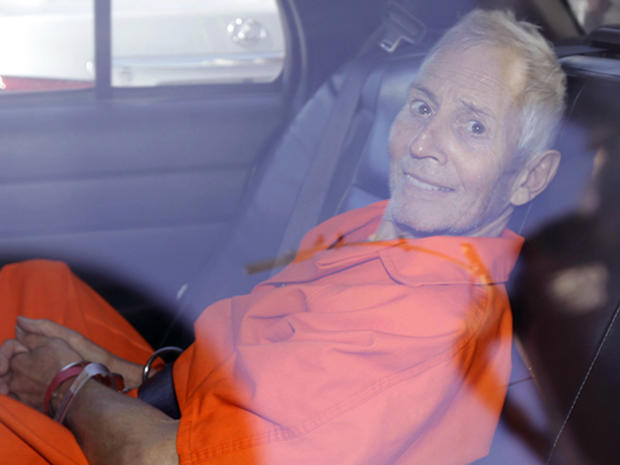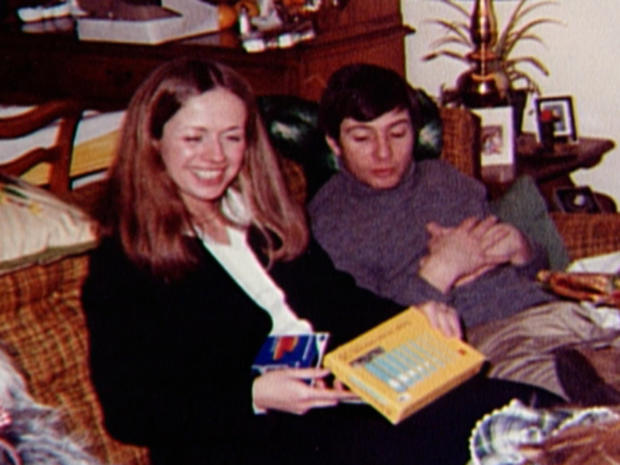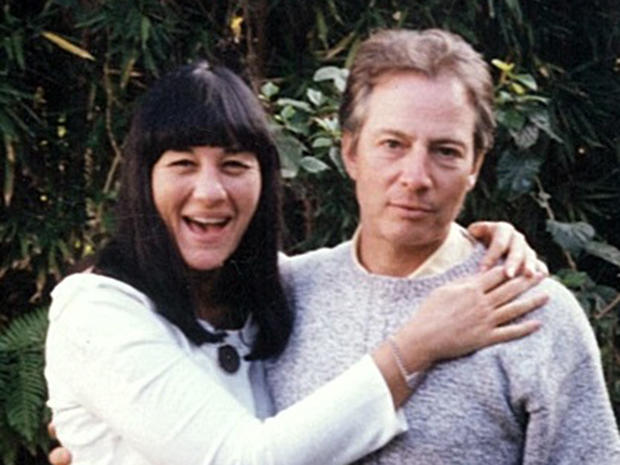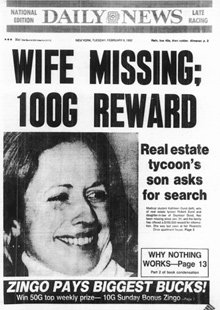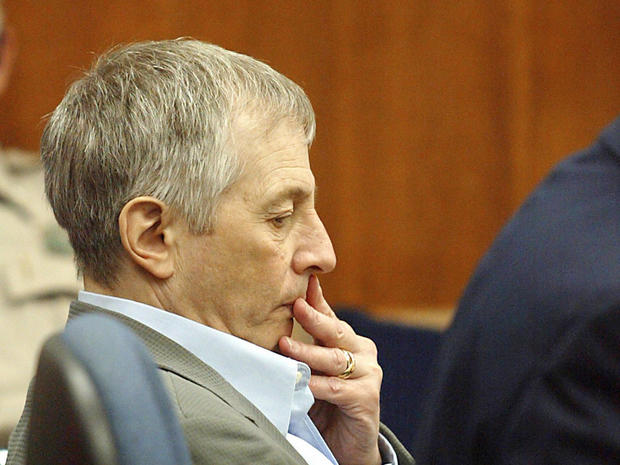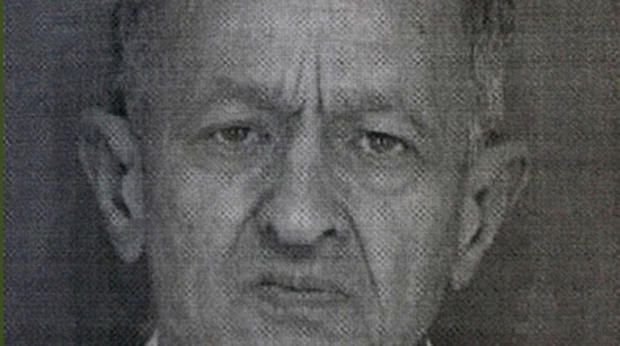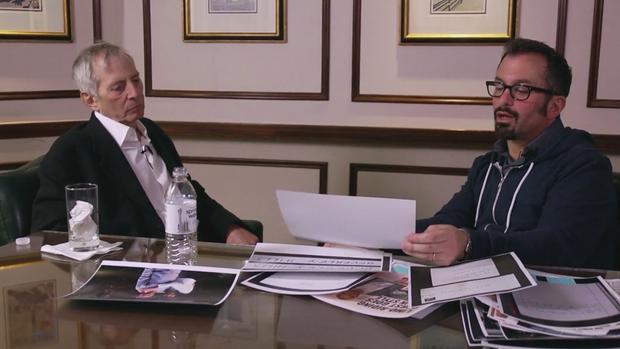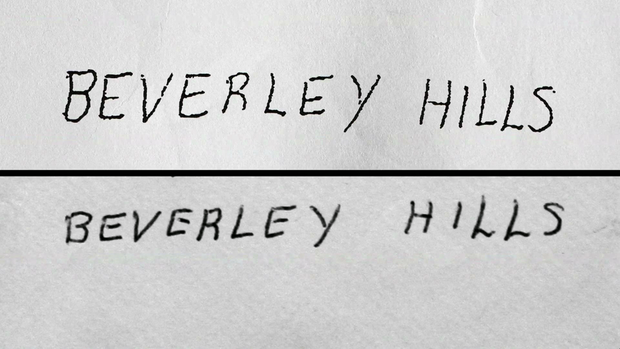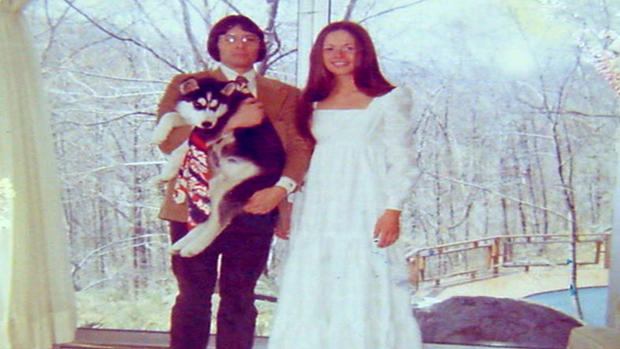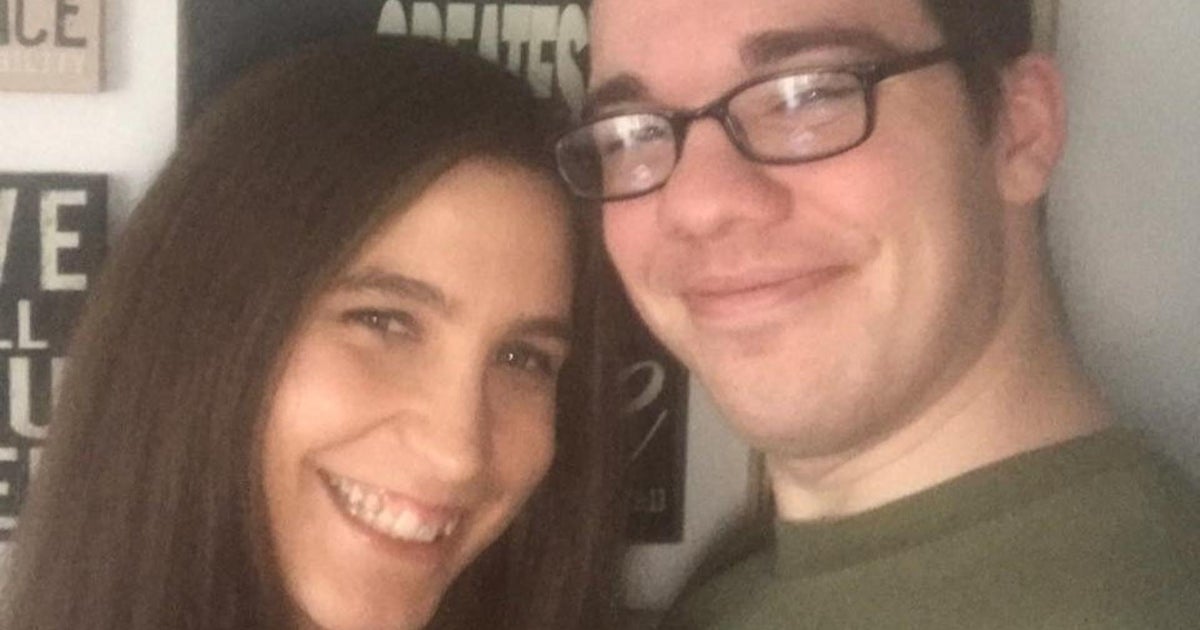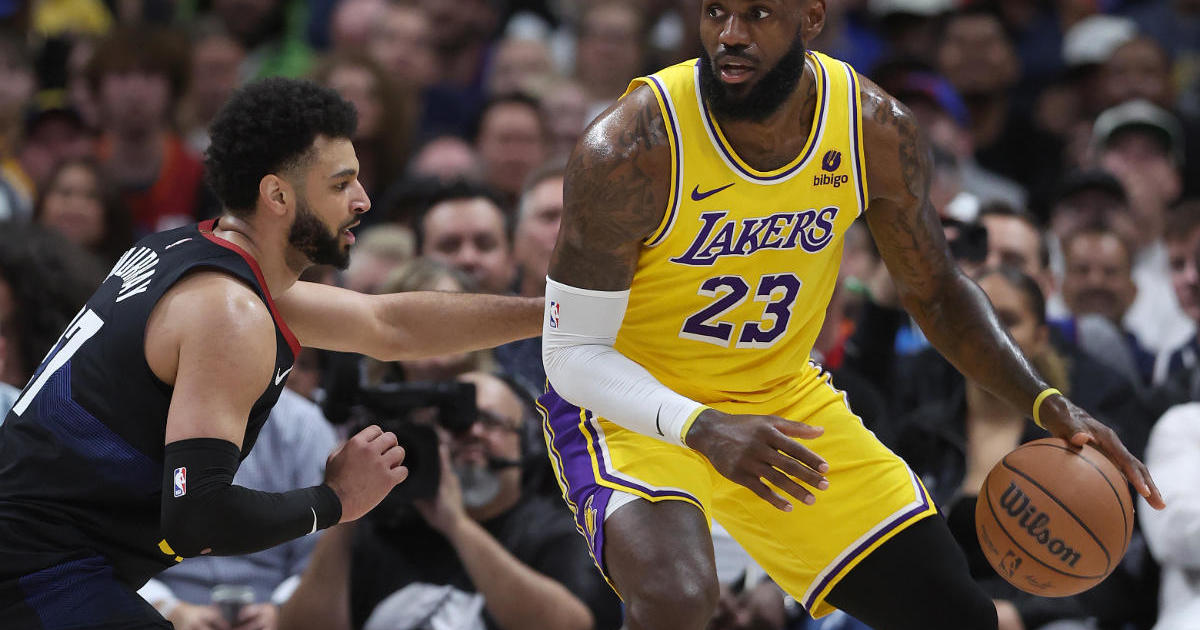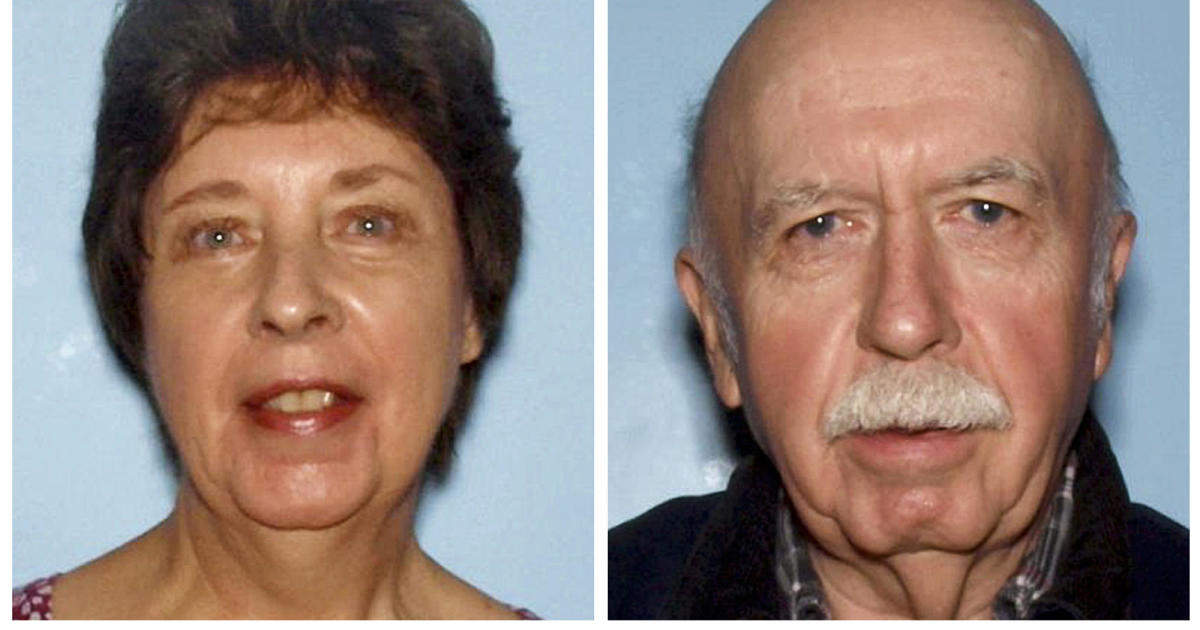Murder in Beverly Hills
Produced by Chuck Stevenson, Greg Fisher, Judy Rybak, Chris O’Connell and Alicia Tejada
Multimillionaire Robert Durst -- suspected in the disappearance of his first wife, Kathie, and connected to the death of a neighbor, Morris Black -- will soon go on trial in Los Angeles for the murder of Susan Berman.
“I do want to say here and now though, I am not guilty,” Robert Durst said during his Nov. 7, 2016, arraignment in L.A. “I did not kill Susan Berman.”
Durst sits in a jail cell serving time on a federal gun charge, with even bigger problems on the horizon as the murder case against him begins to take shape.
There is new evidence, that ironically comes from the defendant himself, in a conversation with the same Los Angeles County deputy district attorney who will face him in court, John Lewin:
John Lewin: I think Bob that you drove down to Los Angeles.
Robert Durst: ...and killed Susan and drove back?
John Lewin: I do.
Evidence like this interview is rarely made public before a trial:
John Lewin: I know that when you killed Susan that was not something you wanted to do.
Robert Durst: I’m gonna stay away from killing Susan.
Next week in Los Angeles, pre-trial proceedings begin: expect secret witnesses and a battle hard fought by some of the best lawyers in the country -- one side trying to put Durst away for life, the other trying to save him.
It is a complicated story, so it helps to go back to the beginning.
In New York City, there’s rich and then there’s really rich. The Durst family is in that category. They control a billion dollar real estate empire, crowned by the new World Trade Center.
Robert Durst is the black sheep son of the man who built that empire. And at 73, he’s become a bonafide true-crime celebrity.
A lot of that celebrity was powered by an HBO documentary called “The Jinx.” In it, a mumbling Robert Durst appeared to have made a dramatic confession. Was he actually admitting to multiple murders?
Robert Durst | “The Jinx:” Killed them all, of course.
A few years earlier, there was a Hollywood movie about him -- a thinly-disguised crime biography called “All Good Things,” starring Ryan Gosling and Kirsten Dunst.
The true story behind the movie begins back in April of 1973.
Bobby Durst had just married the love of his life, Kathie. He was heir to that real estate fortune; she was a dental hygienist.
Robert Durst to John Lewin: No two ways about it we were in love.
Durst’s world class fortune could buy just about anything -- nights at famous discos like Studio 54, star-studded parties and exotic travel.
“They went to Europe, they went to South America, they went to Bangkok … I mean in the 1970s. Wow,” said Kathie’s brother, Jim McCormack.
Kathie had also started a new career – medical school. But soon the marriage began to run off the rails. Robert Durst himself says they both started having affairs, and Durst also had violent tendencies.
“The one time I saw physical violence was when he was impatient to leave my mom’s house in New Hyde Park. He came in and asked to leave. She didn’t jump up. He turned around walked over and grabbed her by the hair pretty much yanked her off the couch,” McCormack recalled.
“He grabbed her by the hair?” Moriarty asked.
“By the hair -- he kind of pulled her in front of me,” McCormack explained. “In retrospect, I wish I had reacted and ripped his face off.”
More and more, Robert Durst found himself turning to another woman – someone he trusted deeply. She was an old college friend- turned-magazine writer named Susan Berman.
“Susan had a very colorful childhood. Susan was raised like Eloise at the Plaza, only it was by the gangsters in Las Vegas,” said Stephen Silverman. “I first met Susan Berman in 1975 when I was a brand new magazine editor in Los Angeles.”
In 1999, the year before her death, Susan Berman spoke about her life.
“My father was Davie Berman who worked for Myer Lansky and Frank Costello,” she said in a videotaped interview. “These were men who had one skill – gambling – and Nevada was the only place it was legal and holy.”
“All the celebrities would come -- Liberace, Elvis Presley, Rose Marie, Jimmy Durante, the Andrews sisters, whoever was in town was always our guest.”
But Berman experienced some of hard edges of mob life growing up.
“In mob parlance,” she explained, “there’s a word for having your parents die suddenly and tragically by murder, and that is ‘they died an unfortunate death. ... many of my friends do have parents that died ‘unfortunate deaths.’”
Author Lisa DePaulo has written about Berman and her relation with Robert Durst.
“For Susan’s entire life, it was Bobby, Bobby, wonderful Bobby,” she said.
“Susan Berman and Robert Durst met at UCLA when they were both students and there was an instant connection … they became best friends,” DePaulo continued. “They both had these two larger-than-life fathers … and two mentally-ill mothers. Bobby Durst’s mother killed herself by jumping off the roof of their house in Scarsdale. Susan Berman’s mother, as the story goes, killed herself in a mental hospital.”
So when things got tough in Durst’s life, he turned to her.
Robert Durst to John Lewin: Susan was my best friend.
Susan Berman would become an important figure in this story.
In January of 1982, Durst’s wife, Kathie, suddenly disappeared. Her friends say the couple had a fight at their suburban New York weekend house. But Durst tells a very different story. He says he dropped Kathie off to catch a train back to New York City and that’s the last time he ever saw her.
Four days after she disappeared, Durst called the New York City police to report her missing. But that was before he called her friends or family to ask where she was. When questioned by L.A. County Deputy D.A. Lewin, his answer seemed strange.
John Lewin: How come you didn’t call them first, before you called the police?
Robert Durst: I was not looking forward to talking to them at all.
“How did you find out that Kathie was missing?” Moriarty asked McCormack.
“…February 4th, between 8 and 9 o’clock ... the phone rings. It’s Bob,” he replied. “’Jim, this is Bob,’ you know with that raspy kind of voice. I say, ‘Yeah, Bob what’s up.’ ‘Have you seen Kathie.’ I said, ‘No.’”
Asked if he sounded worried, McCormack said, “No, it was almost casual ... and almost rushed to get the phone call over with.”
Back in New York, local media picked up on the story of the real estate millionaire’s missing wife.
Robert Durst turned to his confidant, Susan Berman.
“She became his spokesperson when the media started calling, and asking him questions about his wife’s disappearance,” said DePaulo.
In spite of efforts by police, Kathie’s family and friends, investigators never found her. And the case went nowhere for almost 20 years.
“It is a cold, cold, cold case … when in 2000, the then-Westchester County district attorney reopens the Kathy Durst investigation,” DePaulo explained.
That firey new district attorney was Jeanine Pirro.
“We’ll get to the bottom of what happened to Kathleen Durst one way or the other,” Pirro told reporters.
“I have no reason to believe that she isn’t dead and that this wasn’t a homicide,” she told Moriarty in 2004.
When D.A. Pirro went public with news she was going to track him down, Durst disappeared.
“Has Bob Durst been cooperative in this investigation?” Moriarty asked.
“Absolutely not,” Pirro replied. “We want to talk to Bob Durst, he won’t talk to us.”
Because Durst had vanished. Pirro’s investigators started looking for his confidant, Susan Berman. They finally found her in Los Angeles.
“December 23rd of the year 2000, I remember my investigators coming in and saying ‘Boss, there’s good news and bad news. Susan Berman definitely lives at this address, but she’s dead,” Pirro said. “There’s no doubt in my mind, I believe Robert Durst killed Susan Berman.”
DURST AND THE PROSECUTOR
A lot has happened in the 16 years since Robert Durst vanished and Susan Berman’s body was discovered.
In a nearly three-hour long conversation without his lawyers present, Durst recently talked to the Los Angeles County Deputy District Attorney John Lewin:
Robert Durst: I think you want me to go through details of Susan.
John Lewin: I do.
Robert Durst: …maybe there were two people who killed Susan. …one person could go into the house and shoot Susan. And the other person could be the driver.
“…it’s like he didn’t learn from talking to ‘The Jinx’ how this could put him in trouble,” Jack Leonard of the Los Angeles Times pointed out. “And still, there’s Robert Durst … talking to the prosecutor.”
Robert Durst: I’m very willing to talk to you…
The deputy D.A. tries to get on Durst’s good side, hoping he’ll win his trust and maybe get a confession:
John Lewin: Do you know the biggest problem with “All Good Things?” …Ryan Gosling’s portrayal of you … the real you, he didn’t get.
“This prosecutor,” Leonard explained, “you can tell he’s trying to build a rapport … and he’s really trying to flatter him.”
John Lewin: …you have an incredible sense of humor.
Robert Durst: I have a very dry sense of humor.
“It’s a fascinating interview,” Leonard said. “Like a game of cat and mouse going on.”
John Lewin: You did not just find Susan’s body and somebody else killed her?
Robert Durst: I did not find Susan’s body.
Slowly, but surely, Lewin pushes Durst to talk about the months leading up to Susan Berman’s murder -- after Durst learned authorities were reopening the investigation into his wife’s disappearance.
John Lewin: What made you run?
Robert Durst: See, I really can’t say why did I run when I did.
In November 2000, Durst picked up and moved to Galveston, Texas, and he took on a new identity. He dressed himself as a mute woman.
“Is it fair to call Bob Durst a cross-dresser? Or do you think that was simply as a disguise? Moriarty asked then-Galveston Detective Cody Cazalas.
“Simply a disguise,” he replied.
Cazalas says Durst rented an apartment in a modest complex under the alias Dorothy Ciner.
Longtime close friends of Robert Durst, Emily and Stewart Altman defended his strange behavior in a 2003 interview.
“He was so afraid that he picked up and ran off to Galveston, dressed like a woman. Now, can you imagine the fear that must have been in his mind,” said Stewart Altman.
“He really thought Jeanine Pirro was trying to make her political life on Bob’s back,” Emily Altman said.
“And,” said Stewart, “he actually believed an indictment was imminent, for something he didn’t do,”
A month after he went to Galveston in December 2000, and 1,600 miles away in Los Angeles, homicide detectives were investigating the murder of Durst’s best friend Susan Berman - whose body was found on Christmas Eve.
Paul Coulter, now retired, was a detective with the Los Angeles Police Department. He says the life of the one-time mafia princess now played more like “Down and Out in Beverly Hills.”
“She was drivin’ an old clunker car. She was behind in some of the bills,” Coulter explained. “She was --behind in her rent payments … She’d had run-ins with her landlady over … the conditions of the … residence. She was pretty much livin’ destitute. She was embarrassed by those living conditions.”
“How was she killed?” Moriarty asked.
“She was shot in the back of the head,” said Coulter.
“One shot?” Moriarty asked.
“One shot in the back of the head,” Coulter replied. “...to me, you shoot ‘em in the back of the head so you don’t have to face ‘em when you kill ‘em. And I mean that’s just it. There was no forced entry into the residence, there was not ransacking to the residence, and it’s just the way that the body is laying there -- like somebody just left her there and got outta dodge.”
“The initial reaction was her father was in the mafia, she was shot in the back of the head, this is like a mafia hit. And I thought, ‘the mafia isn’t after Susan,’” said Silverman.
Paul Coulter says the way Berman’s body was left at the scene tells him she knew her killer.
“Somebody rolled her over or -- or placed her in that position,” he said.
“Why would you do something like that?” Moriarty asked.
“Because you care for that person,” Coulter explained. “You’re not just leavin’ ‘em slumped like that … They want her body found so it could be properly taken care of.”
And then there was a letter postmarked the day before Berman’s body was discovered.
“And it’s ... addressed ‘Beverley Hills Police Department’ with her address and -- the word ‘cadaver’. And again, to me that means it’s somebody that knows her, cares for her, doesn’t want her laying there … decomposing. They want her body found in a timely manner,” said Coulter.
As part of the investigation, Coulter learned that Berman had received two large checks from Robert Durst shortly before her murder.
“How much money had Durst sent her? And how did you find that out?” Moriarty asked.
“Well, through her bank records and there was a deposit of a large sum of money,” said Coulter.
John Lewin: In November, you said you sent her $50,000.Correct?
Robert Durst: Two checks for $25,000 --
John Lewin: Yeah, for $25,000.
Robert Durst: Apiece.
In his interview with the L.A. County prosecutor, Durst admits he gave Berman the money, but said he was just helping out an old friend:
Robert Durst: I remember giving her money whenever she asked for it.
At that time Durst was not even a prime suspect. Berman had problems with her landlady and a former manager and there was that talk that her death might be a mob hit.
“Susan Berman had cried out soon before her murder that she was about to expose the mob, and really writing something, a tell-all book, of what she knew. That’s why she was murdered,” said Chip Lewis, a member of Robert Durst’s defense team.
“If you realistically look at it, what would be the motive for the mob to kill her? Plus, all the old mobsters from her dad’s era were probably 100 years old or dead,” Coulter pointed out.
Nine months after Susan Berman’s murder, Robert Durst rose to the top of the suspect list when something shocking happened back in Galveston, Texas -- something that made police in three cities believe that Robert Durst could be a serial killer.
THE KILLING OF MORRIS BLACK
In late 2001, several garbage bags full of human remains washed up on the Gulf Coast of Texas and led police directly to Robert Durst.
“It was stunning,” New York Times reporter Charles Bagli said. “We get word out of Galveston, Texas that Bob … Durst has been arrested … for murder, for dismembering a neighbor and tossing the body parts into -- Galveston Bay.”
Durst was charged with killing his neighbor, Morris Black.
Cody Cazalas, Galveston Major Crimes detective at that time, said that he had rarely seen a more clear-cut case of murder.
“He probably walked up behind him and shot him in the back of the head,” Det. Cazalas told Moriarty.
But Durst said that’s not how it happened at all. He claimed that on the night of the shooting, he arrived home to find Morris Black sitting in his living room, with his gun.
Durst was charged with first-degree murder. At his trial, he testified that he and Black had an argument. According to an animation presented by the defense, it was during a struggle that the gun went off, killing 71-year-old Black, accidentally. But Det. Cazalas was unconvinced.
“There was nothing to suggest self-defense. He never said self-defense until after the defense attorneys got the case,” he said.
Durst’s claim of self-defense was even harder to believe because of what he did after the shooting. Instead of calling 911, he carved up Black’s body, shoved the parts into plastic bags, and dumped them into the Galveston Bay.
“What kind of person would you say would be capable of cutting up another person’s body? Someone he says was a friend of his?” Moriarty asked the detective.
“A psychopath. Someone with no conscience,” he replied.
Cazalas believed that Durst used a bow saw to cut off Morris Black’s arms, legs and head.
John Lewin: So, by the way, cutting somebody up with a saw is a really difficult thing to do.
Robert Durst: I agree
In the newly-released interview, Durst casually details the dismemberment for John Lewin:
Robert Durst: Cutting up that body the way I was doing it, was the hard way. The proper way is what a surgeon would do with a scalpel and he would cut around the ligaments and then do the joint, not on the bone.
“We’re talking a very bloody process here,” Moriarty commented to Cazalas.
“Extremely bloody. There was body parts in different bags. There was, like, a leg in one bag, another leg in another bag,” he explained. “I think he assumed that the tide would take the bags on out to the sea, but instead the tide was coming in, and so the bags just stayed right there by the pier.”
But Black’s head -- where he had been shot -- was never found, so the police could not determine whether it was an execution or simply an accident as Durst claimed.
“According to Durst’s lawyers, the reason why he cut up the body was just to try to hide it, that -- that he panicked,” said Moriarty.
“He didn’t panic. …Everything he did was cold and calculating,” Cazalas said. “I have him on videotape, four to five hours after the murder, calmly buying a money order to pay Morris Black’s rent so that it would appear that Morris Black just paid his October rent, and sometime within October moved away. …And this guy is in the video just calm as a cucumber.”
“He’s not a danger to anybody. The public doesn’t know what we know,” attorney Dick DeGuerin said in 2003.
Durst had the best defense team money could buy in Texas, including Dick DeGuerin and Mike Ramsey. One of the first things they did was hire well-known Houston Psychiatrist Milton Altschuler to help figure Durst out.
“Do you think Robert Durst is a dangerous man?” Moriarty asked Dr. Altshuler.
“No ma’am,” he replied.
Dr. Altschuler explained that Durst suffers from a form of autism that at the time was called Asperger’s syndrome, a disorder that can limit a person’s ability to interact socially.
“Emotion is very difficult to him,” said Dr. Altschler.
“Are you saying that Robert Durst can’t feel any emotion?” Moriarty asked.
“He can feel it,” Dr. Alschuler explained. “It’s very dulled, at best, to him.”
Dr. Altschuler asserted that because Durst can’t feel strong emotion, he can’t get angry enough to kill.
“Some people, though, will listen to you and say, ‘Oh, come on. This was just a diagnosis set up for trial to, you know, help him get off the hook of this murder case,” said Moriarty.
“I understand that,” Dr. Altschuler said. “But his whole life’s history is so compatible with a diagnosis of Asperger’s disorder.”
While Dr. Altschuler never testified about his findings, his diagnosis was used at trial.
“It would have been an explanation for some of the inappropriate--and obviously it was inappropriate to dismember a corpse -- behavior that -- that Bob went through,” Mike Ramsey said in December 2003.
But in that newly-released interrogation video, Durst finally reveals his thoughts on that diagnosis:
John Lewin: So the whole Aspergers thing…
Robert Durst: I never thought that amounted [to] anything, that was the psychiatrist coming up with an explanation and it was never necessary at the trial.
John Lewin: But Bob, you agree that was a load of bulls--- by the shrink.
Robert Durst: Yeah.
But after a seven-week trial and five days of deliberation in 2003, the verdict shocked everyone -- even the defendant himself: not guilty.
“That was the most emotional three days of my life. We -- we cried. I broke down a couple of times,” a male juror told Moriarty.
The jurors were widely criticized for the acquittal, but say they felt they had no choice. While they knew Durst had cut up Black’s body, they weren’t convinced he was guilty of premeditated murder.
“Robert Durst was on the stand himself for three or four days. The prosecution had an opportunity to trip him up and put holes in his story. They couldn’t do it,” the male juror explained. “He was on trial for the murder of Morris Black, and there was no evidence that that happened.”
But Detective Cazalas still believes Durst killed Morris Black because Black figured out who Durst really was and became a threat.
“Do you think Bob Durst got away with murder?” Moriarty asked Det. Cazalas.
“There’s not a doubt in my mind. There isn’t a doubt in my mind,” he replied.
“What’s the chance that one guy has two people disappear out of his life?” Moriarty asked the jurors.
“Come on!” the male juror exclaimed. “There’s a possibility -- there is a possibility that Robert Durst is the most unlucky man in America.”
“You believe that?” Moriarty asked.
“I said there’s a possibility,” he replied.
But Durst’s luck was about to run out, and he would only have himself to blame.
He agreed to be interviewed for a six-part documentary series about his life and said things that would eventually help him get charged with Susan Berman’s murder.
A STORY MADE FOR THE MOVIES
Ryan Gosling clearly got something right in his thinly veiled portrayal of Robert Durst, in Andrew Jarecki’s 2010 film, “All Good Things.” The movie that caught the attention of Durst himself.
“He voluntarily called me around the time my film was coming out and said I heard about this movie I’d like to see it. And then he volunteered to come and sit for an interview,” Jarecki said during in an interview with “CBS This Morning” on March 16, 2015.
“…when I asked him why he sat for these interviews … he told me that he thought he could say anything he wanted,” said Charles Bagli, who covers the eccentric multimillionaire for the New York Times.
He says Durst believed he was immune to prosecution.
“This was an old case and no prosecutor would go to the expense of bringing a case against him … 33 years after his … first wife disappeared and all these many years after Susan was murdered,” Bagli explained.
“He was wrong, wasn’t he?” Moriarty asked.
“He was absolutely wrong,” Bagli affirmed.
Durst’s interview with Jarecki became the foundation for the six-part HBO documentary series, “The Jinx: The life and Deaths of Robert Durst.”
“I will be able to tell it my way...” Durst said in the series’ second episode.
But that’s not what happened, says Durst’s lead attorney, Dick DeGuerin.
“Bob trusted them to do a good job in telling his story which he wanted to tell. And that trust was misplaced. And I think that they were not truthful with him from the very beginning as to what their intention was,” he told Moriarty.
In Jarecki’s documentary, Durst seems to incriminate himself, especially when it comes to evidence like the so-called “cadaver note” -- that anonymous letter sent to police at the time of Susan Berman’s murder, telling them there was a body in the house.
“So, obviously I want to ask you about the cadaver note,” Jarecki told Durst.
The envelope, addressed to the Beverly Hills Police, held an important clue: the word “Beverly” was misspelled “Beverley.”
Berman’s stepson gave “The Jinx” filmmakers a letter written to Susan Berman by Robert Durst. And just like the cadaver note, the word “Beverly” is misspelled “Beverley.”
In his final interview for “The Jinx,” Durst was confronted with both letters.
“The Jinx” (Episode 6):
Andrew Jarecki: Can you read me the spelling of “Beverly Hills”?
“The Jinx” (Episode 6):
Andrew Jarecki: Can you tell me which one you didn’t write?
Robert Durst: No.
But the most explosive moment in the series wasn’t the comparison of the curious letters. It was a controversial piece of audio, recorded without Durst’s knowledge, while he was in the bathroom. Durst began muttering to himself:
“The Jinx” (Episode 6)“
Robert Durst: There it is. You’re caught. Killed them all, of course.
“How damaging is that scene in ‘The Jinx?’” Moriarty asked Bagli.
“It was breathtaking,” he replied. “I was at Andrew Jarecki’s apartment for the broadcast of the final episode. … and in the room were Kathie Durst’s brother and, his wife and their daughter. …There was a very quiet sobbing -- through much of that episode.”
“What was your reaction when you heard that?” Moriarty asked DeGuerin.
“My first reaction was what in the world are these guys doing to send someone into the bathroom ….there’s not a more private place… and they know that Bob talks to himself … and that’s just one of his quirks,” he replied.
“When you listen to that, didn’t Bob Durst confess to murder?” Moriarty asked.
“No,” said DeGuerin.
“How else could you interpret that?”
“There’s 100 ways of interpreting it,” DeGuerin replied.
In March 2015, as that final episode of “The Jinx” was about to air, Durst vanished again, and officials feared he was on the run.
“’The Jinx’ is what spurred ‘em into action when they went and arrested him,” said DeGuerin.
“Do you think that this prosecution would be happening at all without the film, ‘The Jinx?’” Moriarty asked.
“I do not,” DeGuerin replied. “I know that the prosecution team has been working on this for years and years. But why now?”
Robert Durst was apprehended in a hotel room in New Orleans and arrested for possession of a gun. That’s when top Los Angeles prosecutor John Lewin made his bold move, flying to Louisiana to interview Durst in the early morning hours, before the defense team arrived.
Durst tried to raise doubt about his seemingly incriminating statements in “The Jinx.”
Robert Durst to Lewin: I was on meth. The whole time I was on meth.
“Personally, I don’t believe that. He didn’t look like a jumpy guy. He looked like a guy that … had smoked a lot of pot and was … kinda down, if anything,” said Bagli.
And Lewin clearly wasn’t buying it.
John Lewin: I’m gonna lay my cards on the table. I don’t think you feel that badly about Morris. …I don’t know how you feel about Kathie. But, here’s what I do know. I know that, when you killed Susan, that was not something you wanted to do. Do you know how I know that?
Robert Durst: Um, I’m gonna stay away from killing Susan.
Lewin’s theory of the crime is pretty clear: he believes Susan Berman was killed because she knew too much about Kathie Durst’s disappearance.
“He brings up what Robert Durst had talked about in ‘The Jinx,’ that Susan Berman had called him and told him that detectives … had wanted to talk to her about Bob Durst’s missing wife, and that she was planning on talking to them,” said Jack Leonard.
Robert Durst: Susan definitely told me that she had been contacted by them.
John Lewin: I’m gonna tell you something. That wasn’t true.
Lewin then takes Durst by surprise:
John Lewin: They had not contacted her. They were planning on contacting her. …Susan lied to you about that.
“It’s like he’s stunned-- for a moment,” Bagli said of Durst’s reaction.
John Lewin: I think that Susan was trying to subtlety squeeze you for money.
Lewin also tries to catch Durst off guard with that infamous cadaver letter:
John Lewin: You know that the killer left a note, right?
Robert Durst: I know that.
John Lewin: The cadaver note. …why would you think the killer would have left a note?
Robert Durst: I’m gonna stay away from that.
But Lewin continues to push:
John Lewin: One of these is the one you wrote to Susan before. And one of them is the cadaver note. Can you tell me which one of these you didn’t write?
Robert Durst: No, I couldn’t begin to.
John Lewin: Yeah, ‘cause they look identical. Agreed?
Robert Durst: If not identical, extremely similar.
The one real difference? The cadaver letter was written in green ink.
John Lewin: You like green pen. Why do you like green pen?
Robert Durst: I liked it. It was different.
John Lewin: OK.
Robert Durst: People recognized “Oh, it’s Bob’s handwriting.”
“John Lewin was very smart to get down there and conduct that interview and get whatever he could out of it,” said former Los Angeles County District Attorney Steve Cooley.
“How damaging is it that Durst admits he loves to write in green ink?” Moriarty asked.
“About as damaging as it is -- when they searched his place down in … Houston,” Cooley replied, “all of his pens were in green ink.
John Lewin: Whoever wrote the note was a part of killing her?
Robert Durst: Yes.
John Lewin: You agree, right?
Robert Durst: Yes.
John Lewin: No question, right?
Robert Durst: Whoever wrote that note had to be involved in Susan’s death.
“If they can connect that letter, and you believe they can, to Robert Durst, the fact that he’s then admitted, whoever wrote that letter was part of the killing,” Moriarty noted to Cooley.
“Right. That’s … almost an admission. It’s an acknowledgement,” he replied.
And it may explain why Durst does something rather shocking; he appears to be fishing for a deal:
Robert Durst: If there’s something that I could do that would be worthwhile for somebody else --
John Lewin: Well –
Robert Durst: -- and they could do something for me --
John Lewin: OK --
Robert Durst: -- then -- then, you know, there’d be a direction.
“Bob was astoundingly close to the edge,” Bagli observed of the interview. “You had a feeling that maybe he would fess up.”
LOOKING FOR A DEAL?
Robert Durst: Kathie started doing all these things to start fights … and then go tell her friend “Look what he did to me.” ... if she could prove that I’d been beating her up, she would get a bigger settlement.
John Lewin: Right.
That’s Robert Durst talking about the tense days before his wife, Kathie disappeared 35 years ago.
Robert Durst: Maybe she accepted that I was gonna be – get a divorce, but she didn’t want me … to look like I came away the winner so she had to get a lot of money…
The fact that Durst is telling these intimate details to the same man who will prosecute him for the murder of Susan Berman infuriates Durst’s lead attorney, Dick DeGuerin.
“I was angry. I was angry that the prosecutor had gone in and talked to Bob Durst knowing that he was represented by lawyers and that the lawyers were on their way to talk to him,” said DeGuerin.
“… he’d had no sleep. He’d been up over 24 hours. He’d been-- suddenly arrested,” DeGuerin continued. “He was tired. He was confused.”
“It’s gonna be a battle royal,” DeGuerin said of the upcoming trial.
And what disturbs DeGuerin even more is that the prosecutor recently filed the full video of that conversation, making it public
“Making a public filing like that was an effort to … to hurt Bob in the public’s eye,” said DeGuerin.
Durst’s admissions may be damaging at trial.
“When you listen to Robert Durst in that interview, it sounds like he’s pushing for a deal,” said Moriarty.
“No,” DeGuerin said smiling.
Robert Durst: If there’s something that I could do that would be worthwhile … and they could do something for me….
John Lewin: OK.
Robert Durst: …if you’d like some details from me, if I knew about where Kathie’s body is … and about what happened with Susan.
John Lewin: And you would agree that you’re in the position, if you want, to tell me more than you have so far…
Robert Durst: Not about that. I’m not about to go that far. …if I tell you these things, I’m pleading guilty.
John Lewin: OK.
Robert Durst: I’m gonna be going back to … California and doing my time.
John Lewin: I’m pretty confident of this. You’re not going to see outside again as a free man.
Robert Durst: So if I was to accept that, I’m not gonna be out of prison. Now the question is, where do I want spend my time?
John Lewin: I don’t control which prison you go to, but I can absolutely make a recommendation.
“Bob Durst is not pushing for a deal. He’s not asking for a deal. He doesn’t want a deal. He wants to be found not guilty as he is,” said DeGuerin.
DeGuerin predicts this trial will be unlike any other.
“I can’t disparage the prosecution team at all. They’re tough. They are good at what they do,” DeGuerin said. “I think I’ve put together a pretty good team, too.”
It’s an all-star legal team that has reportedly already cost Durst $4 million.
“… you’ve got maybe the most formidable legal dream team since the O.J. murder case,” Jack Leonard explained. “Dick DeGuerin. He’s the guy who’s wearin’ a cowboy hat, walkin’ into court. He really is a legend in Texas law… And he’s the guy who helped get Robert Durst off his murder case in Galveston.”
From the West coast, more high-powered defenders, like David Chesnoff.
“...he’s represented, Brittany Spears, he’s represented Paris Hilton, Mike Tyson,” Leonard explained.
And a leading L.A. trial attorney, Don Re.
On the other side, top prosecutors Habib Balian and John Lewin, the one who convinced Durst to talk and who is also known as “the king of cold cases.”
“That man kills witnesses. That’s what he does,” Lewin said of Durst in a court hearign on Jan. 6.
This week, the state is bringing in a secret witness to testify as they move closer to the trial.
Prosecutors claim that Robert Durst is so dangerous, they have to keep the name of this witness under wraps.
“In the filing it says, ‘Defendant has demonstrated a willingness to use deadly force to escape justice and has killed witnesses before,’” Moriarty noted to DeGuerin.
“That’s their claim. I mean, that’s their whole -- their whole basis of this prosecution. They think that … Susan Berman was killed because she was a witness. They think that -- Morris Black was killed because he was a witness. There’s no evidence of that,” he replied.
“But in fact, when you saw ‘The Jinx,’ I think a lot of people who saw that and saw Robert Durst’s handwriting on letters to Susan Berman and saw the ‘cadaver letter,’ the hand writing -- even Robert Durst says the handwriting looks exactly the same. He can’t tell the difference,” Moriarty pressed.
“The Jinx”:
Andrew Jarecki: And can you tell me which one you didn’t write?
Robert Durst: No.
“That’s pretty damaging evidence,” Moriarty noted to DeGuerin.
“I wouldn’t -- I wouldn’t agree with that. But I’m not gonna get down in the weeds with you and discuss that evidence. I’m just not gonna do it,” he replied.
“The green ink cinched it for me. Robert Durst only writes in green ink -- green, the color of money that he loves so much,” former Westchester County, N.Y., Prosecutor Jeanine Pirro
said. “When he was arrested in Galveston, there were green pens, green ink, the man loves green.”
“And the cadaver note? Green ink?” Moriarty asked.
“It’s in green ink. Yes, it is,” Pirro affirmed.
But while some want to see Durst convicted, others just want justice for Susan Berman: a talented writer and larger-than-life personality.
“I miss her,” Silverman said. “…you need people like Susan in your life. You know, there’s so many dull people. Susan was never, never dull.”
This may be the final chapter in the 35-year-long saga of Robert Durst. Many believe his luck has run out -- that he will finally be convicted of murder. His attorney says don’t count on it.
“Bob Durst did not kill Susan Berman and he does not know who did,” said DeGuerin.
“You know, ah, I’ve known Bob for over 15 years. And I’ve seen the toll that being under suspicion for, what’s practically a lifetime, can have on a person,” he continued. “Bob was arrested because of a television program. And I haven’t seen anything to dissuade me from that yet.”
Next week a secret witness in the Susan Berman murder case will reportedly offer new incriminating testimony about Robert Durst.
Kathie Durst’s family has filed a civil suit against Robert Durst. They’re asking for $100 million.
